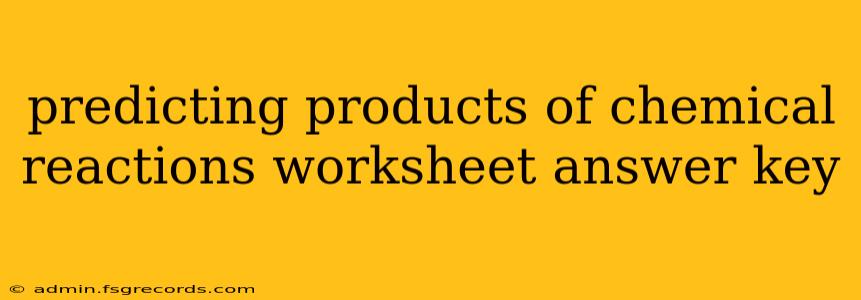Predicting Products of Chemical Reactions: A Comprehensive Guide with Worked Examples
Predicting the products of chemical reactions is a cornerstone of chemistry. This skill requires a solid understanding of reaction types, balancing equations, and recognizing patterns in chemical behavior. This guide will walk you through various reaction types, provide strategies for prediction, and offer worked examples to solidify your understanding. We'll move beyond a simple answer key to provide a deeper, more practical understanding.
1. Identifying Reaction Types
Before attempting to predict products, accurately identifying the type of reaction is crucial. Common reaction types include:
-
Synthesis (Combination) Reactions: Two or more reactants combine to form a single product. The general form is A + B → AB. Example: 2Na(s) + Cl₂(g) → 2NaCl(s)
-
Decomposition Reactions: A single reactant breaks down into two or more simpler products. The general form is AB → A + B. Example: 2H₂O(l) → 2H₂(g) + O₂(g)
-
Single Displacement (Substitution) Reactions: One element replaces another in a compound. The general form is A + BC → AC + B. The reactivity series is crucial here to determine if the reaction will occur. Example: Zn(s) + 2HCl(aq) → ZnCl₂(aq) + H₂(g)
-
Double Displacement (Metathesis) Reactions: Two compounds exchange ions to form two new compounds. The general form is AB + CD → AD + CB. Precipitates, gases, or weak electrolytes often indicate this type of reaction. Example: AgNO₃(aq) + NaCl(aq) → AgCl(s) + NaNO₃(aq)
-
Combustion Reactions: A substance reacts rapidly with oxygen, often producing heat and light. Complete combustion of hydrocarbons produces carbon dioxide and water. Example: CH₄(g) + 2O₂(g) → CO₂(g) + 2H₂O(g)
-
Acid-Base Neutralization Reactions: An acid reacts with a base to form water and a salt. Example: HCl(aq) + NaOH(aq) → NaCl(aq) + H₂O(l)
2. Strategies for Predicting Products
-
Identify the Reaction Type: Carefully examine the reactants to determine the type of reaction occurring.
-
Apply the General Form: Use the general form of the reaction type to predict the possible products.
-
Consider Reactivity: For single displacement reactions, consult a reactivity series to determine if the reaction will proceed. For double displacement reactions, consider solubility rules to predict precipitate formation.
-
Balance the Equation: Ensure the number of atoms of each element is the same on both sides of the equation.
-
State Symbols: Include appropriate state symbols (s, l, g, aq) to indicate the physical state of each substance.
3. Worked Examples
Example 1: Predict the products of the reaction between sodium and water.
- Reaction Type: Single displacement (sodium replaces hydrogen in water).
- Prediction: 2Na(s) + 2H₂O(l) → 2NaOH(aq) + H₂(g)
Example 2: Predict the products of the reaction between hydrochloric acid and potassium hydroxide.
- Reaction Type: Acid-base neutralization.
- Prediction: HCl(aq) + KOH(aq) → KCl(aq) + H₂O(l)
Example 3: Predict the products of the reaction between calcium carbonate and hydrochloric acid.
- Reaction Type: Double displacement (gas evolution).
- Prediction: CaCO₃(s) + 2HCl(aq) → CaCl₂(aq) + H₂O(l) + CO₂(g)
4. Beyond the Basics: Advanced Considerations
Predicting products can become more complex when dealing with organic chemistry, redox reactions, or reactions involving multiple steps. These cases often require a deeper understanding of reaction mechanisms and specific functional groups.
This guide provides a strong foundation for predicting the products of chemical reactions. Remember consistent practice and a thorough understanding of fundamental concepts are key to mastering this essential chemical skill. Further exploration of individual reaction types and their specific nuances will enhance your predictive abilities.

